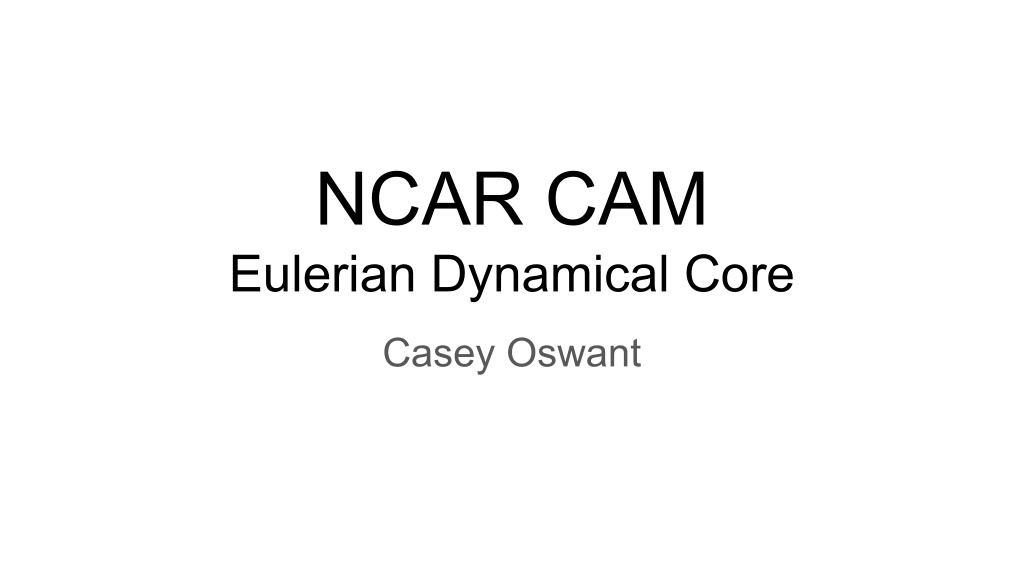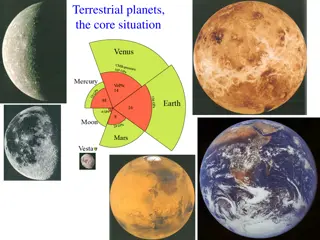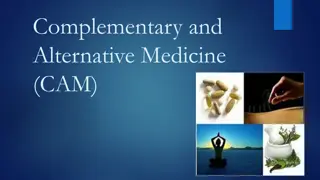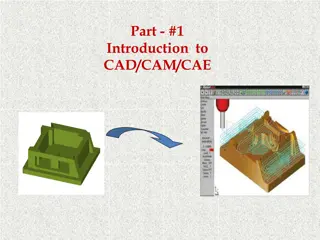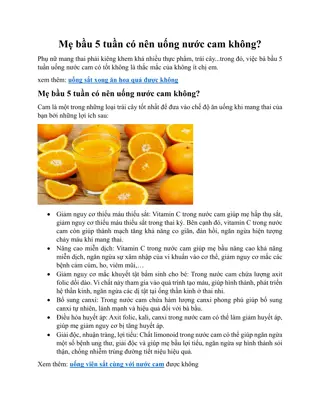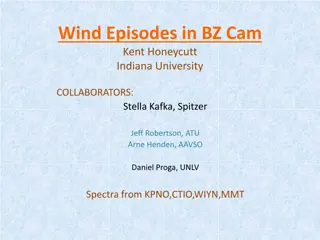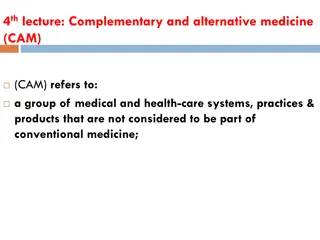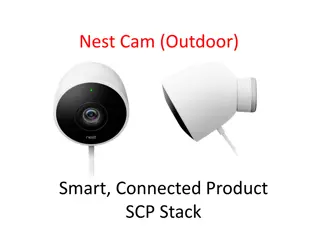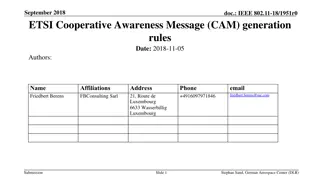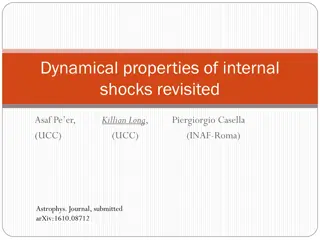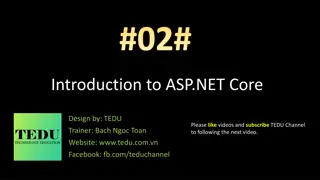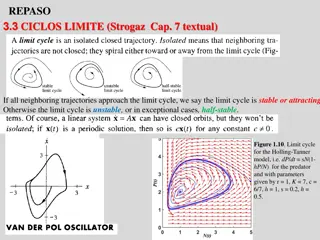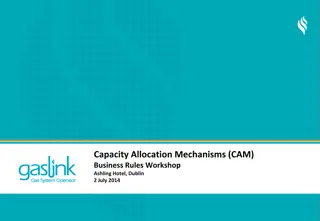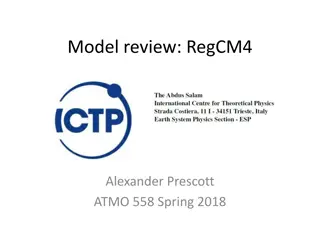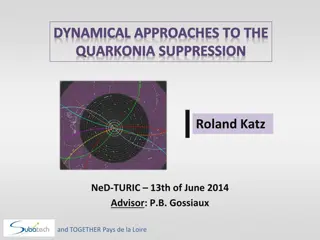NCAR CAM Eulerian Dynamical Core
NCAR CAM Eulerian Dynamical Core, developed by Casey Oswant, is the main component in Version 5 of the NCAR atmospheric global climate model. It cleanly separates the dynamical core and parameterization suite, facilitating easier modifications. The model utilizes a hybrid vertical coordinate, follows terrain using a reduced grid, and incorporates spherical coordinate notation. The governing equations include advection, adiabatic operators, and divergence, with diagnostic equations for hydrostatic vertical advection and surface pressure changes.
Download Presentation

Please find below an Image/Link to download the presentation.
The content on the website is provided AS IS for your information and personal use only. It may not be sold, licensed, or shared on other websites without obtaining consent from the author.If you encounter any issues during the download, it is possible that the publisher has removed the file from their server.
You are allowed to download the files provided on this website for personal or commercial use, subject to the condition that they are used lawfully. All files are the property of their respective owners.
The content on the website is provided AS IS for your information and personal use only. It may not be sold, licensed, or shared on other websites without obtaining consent from the author.
E N D
Presentation Transcript
NCAR CAM Eulerian Dynamical Core Casey Oswant
Overview Version 5 of NCAR atmospheric global climate model. Name changed from Community Climate Model in version 3. Objective is to provide NCAR and the university research community with a reliable and well documented GCM. Cleanly separates dynamical core (DC) and parameterization suite, making it easier to modify/replace each in isolation. DC can be coupled to parameterization suite by time splitting or process splitting. Uses hybrid vertical coordinate that is terrain following. Hydrostatic model. Runs on a reduced grid--- based on latitude and longitude circles in which the longitude grid increases at latitudes approaching the poles so the longitudinal distance between points is reasonably constant.
Terrain Following Hybrid Vertical Coordinate (?) Developed by Simmons and Str fing (1981). Vert. coord. that follows the terrain at Earth s surface but reduces to a pressure coord. at some point above the surface.
Some spherical coordinate notation ?- Latitude ?- Longitude r=z+a, z<<a, so the assumption that r=a is often made.
Advection Adiabatic Laplacian Operator Vertical difference Sources/Sinks Hydrostatic component Vertical Velocity Governing Equations (Prognostic) Momentum Momentum Thermodynamic Moisture ?=surface pressure Continuity equation (Sfc pressure) F H= Source due to horizontal diffusion of momentum F H= Source due to horizontal diffusion of momentum Q= Sources and sinks from parameterizations for momentum. S= Sources and sinks from parameterizations for momentum. FTH= Sources from horizontal diffusion of temperature and a contribution from frictional heating. FFH= Sources from horizontal diffusion of temperature and a contribution from frictional heating.
Advection Adiabatic Divergence Vertical difference Sources/Sinks Geopotential height Absolute Vorticity Governing Equations Cont. Momentum Momentum U,V components Virtual Temp Specific Heat Fu= Sources and sinks from parameterizations for momentum. Fv= Sources and sinks from parameterizations for momentum. R= Gas constant for dry air. Rv= Gas constant for water vapor.
Governing Equations (Diagnostic) Hydrostatic Vertical Advection Surface Pressure Rate of Change
Conversion to Final Form All the previously mentioned equations must be solved by the GCM. To do that need to specify the function ?(p,?) (generalized coordinate). This allows the equations to be in a more convenient form. To do this: Vertical advection terms must be rewritten as: The right hand side of the pressure advection term expanded to: The integrals in the surface pressure equation, pressure advection equation, and vertical motion equation can be written better as:
Conversion to continuous form The solutions to solving the previously mentioned equations are usually noisy due to problems generated in the hydrostatic equation. To solve this, convert the prognostic variable ? to ?. Makes hydrostatic equation quadratically nonlinear except for moisture contributions to virtual temperature.
Time Splitting/Process Splitting Dynamical core can be couple to the parameterization suite in a time split or process split manner. ?- generic variable, D=dynamic core, P= physical parameterization General prediction equation: Three-time-level notation is employed because semi-implicit. Process split: -convenient for spectral transform models. Time split: -convenient for finite volume core which adopts Lagrangian vertical coord.
Semi-implicit formulation In order to derive semi-implicit form, need to linearize equations around a reference state. Momentum and surface pressure equations after isolating the terms that have their linear terms treated implicitly: Advection Adiabatic Hydrostatic component X1, Y1 , Z1: remaining non-linear terms not explicitly written in above equations.
Semi-implicit formulation Terms with ? and are expanded into vertical integrals. 2ln(p) converted to 2 ?.
Semi-implicit formulation In order to linearize, specify a reference state and expand the equations around that state. The expanded equations from the previous slide about the reference state keeping only linear terms: Treats linear terms by averaging in time.
Time Filter Time step is completed by applying a time filter designed by Robert (1966). Could not find the paper online.
More info on DC Energy conservation in the absence of sources and sinks. Horizontal diffusion for T, ?, and to prevent spectral blocking and to provide reasonable kinetic energy spectra. Maintains Zhang and McFarlane (1995) parameterization for deep convection.
CAM 5.0 Total Parameterization Package Precipitation processes Optional dry adiabatic adjustment, moist penetrative convection, shallow convection, and large-scale stable condensation. Clouds and radiation Calculates the cloud parameterization followed by radiation parameterization. Surface model Surface fluxes obtained from land, ocean, and sea ice models, or calculates them based on the current conditions. Turbulent mixing Planetary boundary layer parameterization, vertical diffusion, and gravity wave drag.
References Simmons, A. J., and R. Stru fing, An energy and angular-momentum conserving finite-difference scheme, hybrid coordinates and medium-range weather prediction, Technical Report ECMWF Report No. 28, European Centre for Medium Range Weather Forecasts, Reading, U.K., 68 pp., 1981. Atmospheric and Ocean Dynamics . An Introduction to Three-Dimensional Climate Modeling, by Warren M. Washington and Claire L. Parkinson, University Science Books, 2005, pp. 79 82. Appendix A . An Introduction to Three-Dimensional Climate Modeling, by Warren M. Washington and Claire L. Parkinson, University Science Books, 2005, pp. 305 306. NCAR CAM Scientific Description- http://www.cesm.ucar.edu/models/atm- cam/docs/description/description.pdf
